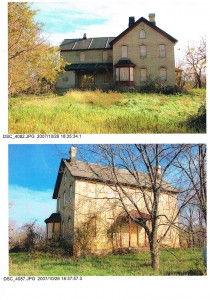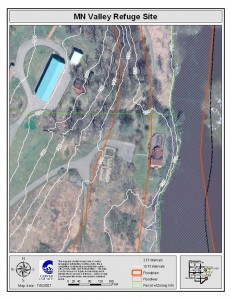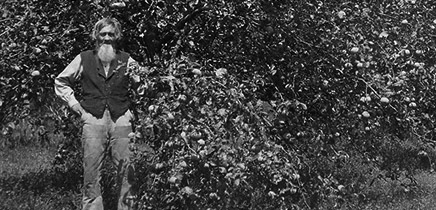The Gehl-Mittelsted Farmstead is located in the far southern part of Carver County, in San Francisco Township. One of Carver County’s many historic properties, the farmstead was placed on Minnesota’s 10 Most Endangered Historic Sites list in 2006.
The farm was founded by Henry Gehl. Gehl was a German immigrant, born in Schwerin, Mecklenberg-Schwerin, Germany on February 13, 1825. At age twenty-five, he joined the thousands of others immigrating to America during the 1850s. Gehl purchased the farmstead in 1867. In addition to the farm, Gehl also ran butcher shops in both Chaska and Carver, which were supplied by his farm. He did well with both. During the 1880s, the large Chaska brick house on the property was built. It was home to Gehl, his wife Christina Sohns Gehl, and their fourteen children.
Henry and Christina’s son Francis Gehl ran the farm after Henry died in 1890. Three years later, Francis married Beda Hurtig. They had two children: Robert (1895) and Herbert (1896). Sadly, just a few short years later on January 24, 1901, tragedy struck. While crossing railroad tracks on his way home from Jordan, Francis was hit and killed, though the horses survived and continued home.
Upon the tragic death of Francis, his brother Herman A.J. Gehl bought the farm. For the next sixteen years until his death, Herman made “Gehl Ranch” one of the largest farms in southeastern Minnesota. At his death, the farm had over forty horses, one hundred cattle, and two hundred hogs. Following Herman’s death, his son, Henry William Gehl, named for his grandfather, took over both the farm and the meat market in February 1934. At this point, the massive farm was at 2,000 acres, 100 cattle, and about 20,000 turkeys. In February 1935, Henry married Stella Winson. They moved to her home town of Excelsior and operated the farm and meat shop with hired help. Henry W. and Stella Gehl had no children. Henry had a sister, Florence Mittelsted, and brother, Charles F. Gehl, still alive at his death. His will gave the farm to his nephew, Gale Mittelsted, with whom he had formed a business partnership, and niece, Shirley Teske.
The last family owners of the Gehl-Mittelsted farmstead were Gale Mittelsted, his wife, and two sons. Trained as a veterinarian, Gale opened a practice in Chaska after being discharged from the military in 1946 after World War II ended. According to family legend Gale was named “Gehl” Mittelsted after his mother’s family, but it was misspelled on his baptism papers, and it became “Gale” instead. The Mittelsted’s lived in Chaska, working the farm with hired help. In 1980, they moved to the farm, where Gale died in 1983. His wife Anita and sons Peter and Gehl remained on the farm until selling it to the United States Fish and Wildlife Service in 1995, making the farmstead a part of the Minnesota Valley Wildlife Refuge.
Although the Fish and Wildlife Service originally planned to turn the house into a Visitor Center, its location on a floodplain, and the fact the house has twice had floodwater reach as high as the floor joists, changed their minds. However, the site still has enduring historic value. Made of Chaska brick, the house is significant for the brick and its early German architecture style. The property was also owned and operated by five generations of the same family, which is historically significant. As part of the Minnesota Valley Wildlife Refuge, the land will not be developed on, divided up, or sold. This will allow the property to be preserved for future generations of visitors. The house is less secure. In 2006, the house and outlying building that remain were placed on a list of Minnesota’s Ten Most Endangered Historic Sites and its future remains uncertain.
Turning Point: In 1995, the US Fish and Wildlife Service purchased the historic Gehl-Mittelsted farmstead, with plans to convert the house to a visitor center and preserve the land as a wildlife refuge for visitors to see.
Chronology:
- February 13, 1825: Henry Gehl is born in Schwerin, Mecklenberg-Schwerin, Germany.
- 1850: Henry Gehl immigrates to America at age twenty-five.
- 1867: Gehl purchases farmland in San Francisco Township, Carver County.
- 1880s: A Chaska Brick farmhouse is erected on the property using early German architectural styles.
- 1890: Henry Gehl dies; son Francis Gehl takes over the farm.
- 1893: Francis Gehl marries Beda Hurtig
- January 24, 1901: Francis Gehl dies in a train accident.
- 1918: Herman A.J. Gehl takes over the farm and makes “Gehl Ranch” one of the largest farms in southeastern Minnesota
- February 1934: Herman Gehl dies and son Henry William Gehl takes over the farm.
- February 1935: Henry W. Gehl marries Stella Winson of Excelsior where they settle, running the farm from a distance with hired help.
- June 1949: Henry W. Gehl dies.
- 1949-1983: Gale Mittelsted operates the farm with hired help while running a veterinarian clinic in Chaska.
- 1980: Gale Mittelsted, his wife Anita and their children move to the farm.
- 1983: Gale Mittelsted dies.
- 1995: The Gehl-Mittelsted property is sold to the United States Fish and Wildlife Service.
- 2006: The Gehl-Mittelsted farm is listed on Minnesota’s Ten Most Endangered Historic Sites list.


Bibliography:
“Contemplates a Meat Market”. Carver Free Press, May 21, 1885.
“Death Robs City of Prominent Man and Business Proprietor”. Weekly Valley Herald, June 6, 1949.
Edwins, Steve and Steve Wilmot, SMSQ Architects. “Gehl-Mittlested Site Reuse Study”. Reuse Brief- Site Value. Minnesota Valley National Wildlife Refuge, December 15, 2007.
Maravelas, Paul Scheftel. “The Gehl Farm in San Francisco Township, Carver County, with some notes on the village of San Francisco, the Little Rapids, and the Wahpeton Village at that place”. Site study. Compiled by the Carver County Historical Society for the U.S. Fish and Wildlife Service, March 15, 1997.
“Married- Henry W. Gehl to Stella Winson”. Weekly Valley Herald, February 14, 1935.
“New Butcher Shop”. Weekly Valley Herald, February 9, 1882.
“Obituary- Henry Gehl”. Weekly Valley Herald, November 27, 1890.
“Public Input Sought on Reuse of Historic House”. Norwood Times, February 28, 2008.
“Soon to Graze in Poland Pastures, Cows from Gehl Ranch Destined for Foreign Duty”. Weekly Valley Herald, December 27, 1945.
“Unfortunate Death of Francis Gehl.” Weekly Valley Herald, January 31, 1901.
Related Resources:
Carver County Historical Society. ”Farmhouses in Carver County: Resources Worthy of Preservation”. Brochure, Minnesota Department of Transportation, April 2011.
Carver County: Today and Yesterday. Compiled by the Carver County Statehood Centennial Committee, 1958. Holcombe, Maj. R.I., editor. Compendium of History and Biography of Carver and Hennepin Counties, Minnesota. Henry Taylor and Company: Chicago, 1915.
Lofstrom, Ted and Lynne VanBrocklin Spaeth. Carver County: A Guide to Its Historic and Prehistoric Places. St. Paul: Minnesota Historical Society Press, 1978.
Martens, Steven C. “Ethnic Traditions and Innovations as Influences on a Rural Midwestern Building Vernacular”. Master’s thesis, University of Minnesota, 1988.
Martins, Steve. “Brick Houses in Carver County”. Student paper, University of Minnesota-Foster Dunwiddie Papers, 1987-1988.
Tremblay, Ruth and Lois Schulstad. Images of America: Carver County. Arcadia Publishing: Charleston, South Carolina, 2011.
[Web]
“Gehl-Mittlested Farmhouse”. Minnesota Bricks. Accessed February 17, 2013. http://www.mnbricks.com/gehl-mittlested-farmhouse
“Minnesota Valley National Wildlife Refuge”. U.S. Fish and Wildlife Service. Accessed February 16, 2013. http://www.fws.gov/refuges/profiles/index.cfm?id=32590
“Site proposal”. U.S. Fish and Wildlife Service. Accessed February 16, 2013. http://www.fws.gov/midwest/nepa/MNValleyVCNEPA/index.htmlhttp://www.fws.gov/midwest/NEPA/MNValleyVCNEPA/Documents/draftEA.pdf
Images/Audio/Video
Subject Files, Drawer G1: Gehl Farm and Gehl Farm Notes. “Gehl-Mittelsted Farmstead” [Description]: Front and side views of the Gehl-Mittelsted Farmhouse as it is in the twenty-first century. Rights held by the CCHS.
Subject Files, Drawer G1: Gehl Farm and Gehl Farm Notes.“MN Valley Fllodway” [Description]: an aerial shot of the MN Valley Refuge site, showing a floodplain view. Rights held by the U.S. Fish and Wildlife Service.
“This article used with the permission of MNopedia, operated by the Minnesota Historical Society, under a Creative Commons License. No changes have been made to the article’s content.”


